The Apple iPad Review (2012)
by Vivek Gowri & Anand Lal Shimpi on March 28, 2012 3:14 PM ESTThe Display: In Numbers
Apple is very big on maintaining a consistent experience between its products. We see this a lot in our Mac reviews where it's not unusual to see similar white points across virtually all Apple products. It's no surprise that the with the move to the Retina Display Apple wanted to retain as much of the original iPad's display characteristics as possible. We'll start with an analysis of brightness and contrast, both of which remain relatively unchanged from the iPad 2:
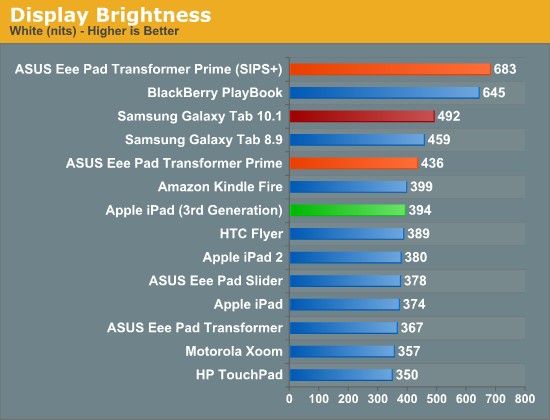
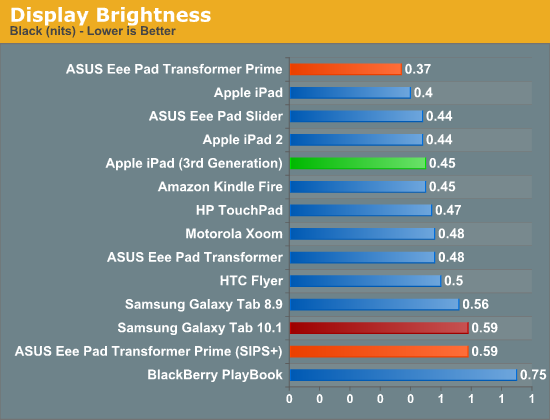
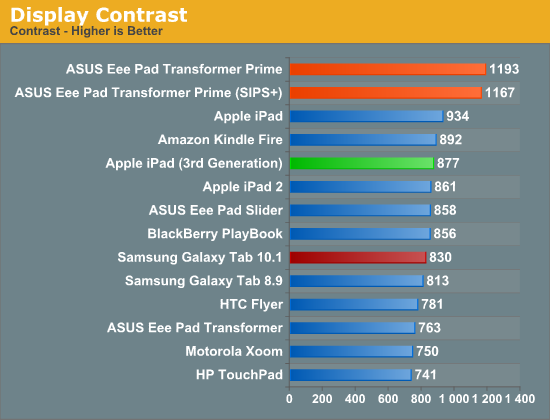
Apple is expected to have triple sourced panels for the new iPad, so you can expect to see variation in these results but for the most part you can expect the new iPad's display to perform similarly to the previous model.
Despite similar brightness and contrast to the previous model, the new iPad offers remarkably better color gamut and color reproduction than its predecessor. Relative to other tablets, the iPad's display is spectacular.
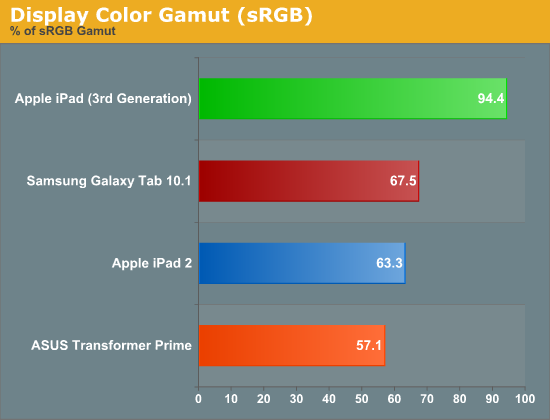
As we mentioned in our Retina Display analysis, Apple delivered on its claims of a 44% increase in color gamut. The new iPad offers nearly full coverage of the sRGB color space and over 60% of the Adobe RGB gamut:
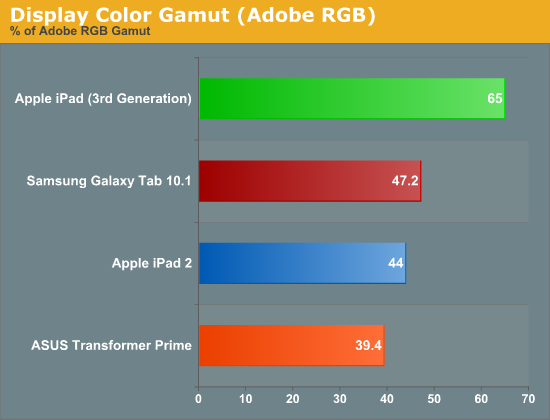
Below is the CIE diagram for the new panel with an sRGB reference plotted on the same chart so you can visualize the data another way:
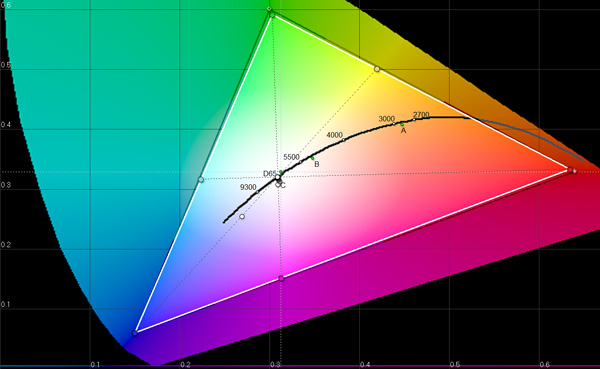
Color accuracy has improved tremendously if we look at delta E values for the primary and secondary colors:
Remember from our display reviews, lower delta E values indicate greater color accuracy. Values below 4 are typically considered good and you can see that the iPad 2 as well as the Transformer Prime both fell short in this department. With the new iPad Apple has clearly focused on color accuracy, which makes sense given it was used as the vehicle to introduce iPhoto for iOS.
Apple still has a lot of work ahead of itself to really put forth a professional quality display in a tablet, but for now the Retina Display is easily the best we've seen in a tablet and a tremendous step forward.
What's most absurd about the iPad's Retina Display is that you're able to get this resolution and panel quality in a $499 device. While we must be careful not to give Apple too much credit here as Samsung, Sharp and its other display partners clearly make the Retina Display, it's obvious that Apple has really been pushing its partners to develop solutions like this.
The biggest problem in the production of any commoditized component is the primary motivation for innovation is to lower cost. For years I argued with notebook PC makers to use higher quality LCD panels but no one was willing to commit to the quantities that would lower costs enough. I was also told that as soon as you put these notebooks on shelves at Best Buy, users wouldn't really care whether they were getting a high quality IPS display or not—all that mattered was the final price.
Apple, under the leadership of Steve Jobs, had a different mentality. Steve's pursuit was quality and experience, cost was a secondary concern. Through slow and steady iteration of this approach, Apple was able to build up a large enough customer base and revenue to be a significant force in the industry when it came to driving costs down. Apple can easily fill your fabs and eat all that you can produce, but you'll have to do whatever it wants to get the order.
Apple's behavior since it got rich has been to drive down the cost of higher quality components, LCDs being a perfect example. Unfortunately other companies don't benefit as much here as Apple tends to buy up all of the production of what it has pushed to create. That's one reason why, although ASUS was first to introduce a 1080p Transformer Pad, it won't launch until well after the new iPad. From what I've heard, the panel makers are all busy servicing Apple's needs—everyone else comes second.
Eventually the entire industry will benefit and all indications point to Apple doing something special for "pro" users in the notebook space next. As I've said previously, Apple has raised the bar with the iPad's Retina Display. The time for average display quality in a $500 tablet is over, the bar has been raised. It remains to be seen whether or not Apple will be able to maintain this quality across all suppliers of its Retina Display. On the iPhone Apple has been entirely too lax about maintaining consistency between suppliers. If it wants to be taken seriously in this space Apple needs to ensure a consistent experience across all of its component vendors.

















234 Comments
View All Comments
sciwizam - Wednesday, March 28, 2012 - link
Did the test suite change from your review of the Galaxy Tab 10.1 LTE?Anand Lal Shimpi - Wednesday, March 28, 2012 - link
It did indeed, let me see if I can't run the updated suite on the Galaxy Tab 10.1 LTE though...Take care,
Anand
jadawgis732 - Wednesday, March 28, 2012 - link
Hey Anand, I always wanted to say how much I admire your reviews, and how unbiased and untouched by corporate dollars they are. Keep up the great work! Also, it's very nice to see you responding to replies in the comments!Anand Lal Shimpi - Thursday, March 29, 2012 - link
Thank you for the kind words and for reading the site :)Take care,
Anand
medi01 - Thursday, March 29, 2012 - link
Samsung Galaxy Tab randomly dissapearing from charts where it would look favourably indeed leaves "unbiased" impression. (For instance color gamut is on par with "ipad 3" and way above ipad2)Anand Lal Shimpi - Friday, March 30, 2012 - link
I promise it's not that sinister :) I simply opted to compare to the best of the best out there today as far as Android tablets are concerned: the ASUS Transformer Prime.I understand the desire for more results so I'll be working on them in the background over the weekend.
Take care,
Anand
xytc - Wednesday, March 28, 2012 - link
I've heard that Apple's strong marketing campaign penetrates pussies, so if you have an Apple product you're nothing but a pussy. LMFAOPeteH - Wednesday, March 28, 2012 - link
Really?MobiusStrip - Thursday, March 29, 2012 - link
"LMFAO"?Wow, low humor threshold.
Wardawg - Thursday, April 5, 2012 - link
Well most people adept in technology or use tech in their buisness use apple products: djs programmers, and others, and frankly I see more iPhones being used than androids. So apparently most of the world is pussies by your definition. Please do research before you bash a company's products